divorce reconciliation michigan pdf free download

Have you ever considered therapy for your marriage?
Have you contemplated therapy before saying, "I do?"
If you're reading this article chances are it's because you're married and struggling, thinking about getting married, or contemplating divorce. You're looking for answers to that age-old question: Can we make this work?
You're not alone.
There's a lot of good news when it comes to getting and staying married. In the US and parts of England, for instance, divorce rates are dropping (Wood, 2018). Younger people are delaying marriage, not avoiding it. They're waiting until they finish school and have money to support a marriage.
As you read, you'll discover that one key benefit is how marriage positively affects your health and longevity. If you're looking for tips, we've got you covered. Keep reading.
Before you continue, we thought you might like to download our three Positive Relationships Exercises for free. These detailed, science-based exercises will help you or your clients build healthy, life-enriching relationships.
What is Marriage Psychology?
The definition of marriage is usually from a legal perspective. In many cultures, though not all, it's defined as between a male and female. Marriage occurs in every status and at various educational levels.
Why do humans pursue this arrangement? Why is it important? Why not live like our relatives the bonobo or chimpanzee? What is it about marriage that garners so much attention?
Researchers from diverse disciplines are exploring this. From an evolutionary perspective, it's viewed as strengthening and perpetuating the species. From a sociological vantage, marriage creates bonds between and among groups. These bonds facilitate the success of the group.
Psychology focuses on the couple. Researchers question every conceivable situation around marriage. For example:
- What brings two people together?
- What keeps them together?
- What breaks them apart?
- How does their union affect their well-being, health, and happiness?
- How does divorce affect the same variables?
- Are we supposed to be monogamous?
- How does having children affect the marriage bond?
- How does divorce affect children?
- How can government actions influence the health of marriage?
- How does stress affect the relationship?
- How does a lack of intimacy affect the relationship?
- What factors increase the odds of divorce?
- How does the person's upbringing affect their romantic relationships?
More recently, researchers are exploring these questions within the context of same-sex couples.
From this exploration, therapists are better able to help couples before, during, and after a crisis.
A Look at the Psychology of Marriage
Relationships can be tricky. Within a married relationship, this is especially true. Aside from ourselves, no single person in our adult lives has as much influence on our health and well-being as our spouse. Countless studies point to this (Robles, Slatcher, Trombello, & McGinn, 2014).
Our partner knows us better than anyone else because of their daily proximity to us. They know our idiosyncrasies. Over time, as we get closer, we can lift each other up and bask in that warmth. The support in our married relationship isn't easily replaced by social support (Holt-Lunstad, Birmingham, & Jones, 2008).
But when things aren't clicking, the situation can take a dive. Squabbles or all-out battles can make it difficult to let go of the hurt. Having a trained professional available to provide evidenced-based support can help.
The training and support therapists use comes from several theories.
Psychological Theories of Marriage
Social Exchange Theory
Social exchange theory posits that there are costs and benefits in potential interactions. People analyze each situation to determine the risks and benefits. Within a marital relationship, this is "the cyclical patterns of transactions of valued resources, tangible or intangible, between partners and the rewards and costs associated with such transactions" (Nakonezny and Denton, 2008).
Cognitive self-disclosure
Edward Waring posited that the way to build intimacy is through self-disclosure. It's a bit like the Newlywed Game. The board game includes a series of questions. These allow you to disclose information in a non-threatening, fun way.
Couples can play alone using only the questions and explore as much as they are comfortable. Each person shares something about their wants, needs, aspirations, attitudes, beliefs, and desires.
According to Leeuw (2015) Waring defined intimacy along eight dimensions. They are:
- Conflict Resolution: how easily couples can resolve differences of opinion.
- Affection: the degree of emotional closeness the couple expresses.
- Cohesion: the feeling that both couples are committed to the marriage.
- Sexuality: how much sexual needs are communicated and fulfilled in the marriage.
- Identity: the couple's level of self-confidence and self-esteem.
- Compatibility: the degree couples can work and play together.
- Autonomy: how couples become independent from their families of origin and their offspring.
- Expressiveness: the degree that thoughts, beliefs, attitudes, and feelings are shared between the partners
Increasing a couple's cognitive self-disclosure is the single best way to increase their level of intimacy (Waring, 1988.)
Duplex Theory of Love
Developed by Robert J. Sternberg, this theory combines two theories. The first is the triangular theory of love. The second, the theory of love. Together they're known as the Duplex Theory of Love.
The first is a combination of three elements, intimacy, passion, and decision/commitment. The center of intimacy is the closeness, connectedness, and bond in the relationship. Think of this as the warm-fuzzy feeling you have for a romantic partner. Romance, physical attraction, and sex make up the passion element of the theory.
The final part of the equation, decision/commitment don't have to happen together. For example, a person could decide to love someone, but not pursue a long-term commitment. One could also commit to a relationship without admitting their love.
Sternberg asserts that each can occur separately or together. There also are eight combinations.
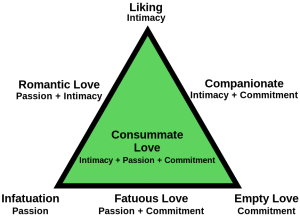
His use of triangles represents the balance or imbalance of the various elements of love. Different triangle shapes show different balances of the three kinds of love. When balanced, an equilateral triangle represents the love relationship.
Theory of Love as Story
Think back to when you first began fantasizing about a future relationship. What basis did you use to qualify a potential mate? How did you decide what qualities you wanted?
For some, media and books form the foundation for what love and loving relationships are. For others, it's through careful observation of the relationships around them. Others might combine both of those to form their perspective on choosing a partner.
Sternberg reviewed literature, film, and oral descriptions of relationships. From this, he identified 26 possible love story genres. He acknowledges the number could be infinite. Sternberg also admitted that the list has some degree of cultural bias. It only included US participants.
Even so, the stories do provide insights into how people conceptualize love. According to Sternberg they are:
- Addiction. Strong anxious attachment; clinging behavior; anxiety at thought of losing a partner.
- Art. Love of partner for physical attractiveness; importance of partner always looking good.
- Business. Relationships as business propositions; money is power; partners in close relationships as business partners.
- Collection. Partner viewed as "fitting in" to some overall scheme; partner viewed in a detached way.
- Cookbook. Doing things a certain way (recipe) results = relationship being more likely to work out; departure from the recipe for success leads to an increased likelihood of failure.
- Fantasy. Often expects to be saved by a knight in shining armor or to marry a princess and live happily ever after.
- Game. Love as a game or sport.
- Gardening. Relationships need to be continually nurtured and tended to.
- Government. (a) Autocratic. One partner dominates or even controls another. (b) Democratic. Two partners equally share power.
- History. Events of relationship form an indelible record; keep a lot of records–mental or physical.
- Horror. Relationships become interesting when you terrorize or are terrorized by your partner.
- House and Home. Relationships have their core in the home, through its development and maintenance.
- Humor. Love is strange and funny.
- Mystery. Love is a mystery and you shouldn't let too much of yourself be known.
- Police. You've got to keep close tabs on your partner to make sure he/she toes the line, or you need to be under surveillance to make sure you behave.
- Pornography. Love is dirty, and to love is to degrade or be degraded.
- Recovery. Survivor mentality; view that after past trauma, person can get through practically anything.
- Religion. Either views love as a religion, or love as a set of feelings and activities dictated by religion.
- Sacrifice. To love is to give of oneself or for someone to give of him or herself to you.
- Science. Love can be understood, analyzed, and dissected, just like any other natural phenomenon.
- Science Fiction. Feeling that partner is like an alien–incomprehensible and very strange.
- Sewing. Love is whatever you make it.
- Theater. Love is scripted, with predictable acts, scenes, and lines.
- Travel. Love is a journey.
- War. Love is a series of battles in a devastating but continuing war.
- Student-teacher. Love is a relationship between a student and a teacher.
How do you conceptualize love? Do you see yourself in any of the previous descriptions?
The Gottman Method
John and Julie Gottman created the Sound Relationship House Theory. He and his wife have studied a variety of relationships for 30 years.
The goal of therapy is to reduce conflict and increase intimacy. This includes a focus on respect and affection. After initial assessments, the couple works with a therapist to refurbish their house.
Every couple's house consists of seven levels surrounded by trust and commitment. These are the insulation. The levels are:
- Build love maps – Show genuine interest in the internal and external world of your partner. Know your partner's dreams, values, and goals. Ask open-ended questions.
- Share fondness and admiration – Communicate affection and respect in small ways, often.
- Turn towards instead of away – Partners tend to make small bids for each other's attention. For example, one might notice something and point it out. If the other partner acknowledges this and responds, then this is turning toward. If the partner continues doing what they're doing then this is an example of turning away.
- The positive perspective – This sentiment overrides moments when negative things are happening. This only occurs when 1-3 are working well in the relationship. Gottman calls this a buffer to irritability and emotional distance.
- Manage conflict – Friendship is the basis for regulating conflict. Couples who have the first three ingredients tend to use humor and affection during conflict. Sixty-nine percent of conflicts are never solved. They're perpetual problems that exist in every relationship.
- Master couples learn how to cope with this over time through discussions. They don't allow them to turn into a gridlock for their relationship.
- Make life dreams come true – Master couples figure out the dreams that are the subtext for the conflict. They honor those dreams.
- Create shared meaning – The couple feels like they're building something together. Their roles within and without the relationship have meaning that supports them.
Gottman explains how to make a marriage work and the research that backs up their theory.
The Five Love Languages
Dr. Gary Chapman developed the five love languages after providing years of marriage counseling. Grounded in Christian principles, the focus is on how to have healthy relationships. Chapman points out that these languages apply to other types of relationships, too.
He determined that five behaviors are essential to a healthy, happy, long-term marriage.
- Love and affirmation; and,
- Learning how to deal with your failures through forgiveness and apology,
- Learning how to handle anger,
- Learning how to listen,
- Accept and laugh about the minor irritations.
These five ideas are the roof, walls, and foundation for the five love languages. The languages are the rooms inside. We don't need to enter every room. We do need to know which one is most important to us and to our partner.
The five love languages are:
- Words of affirmation – Remember how your parents taught you to say, "please" and "thank you"? Sometimes we forget this simple tip in our relationships. The bottom line is we all love positive words from the people we respect and love.
- Gifts – This is what tells the other person that you're thinking about them. They don't need to be expensive. They do need to be thoughtful.
- Acts of service – Doing things for your spouse like household chores fall into this category. Doing them without being asked is even better if this is your partner's love language.
- Quality time – Spending uninterrupted time together listening and talking creates stronger bonds. The TV/computer/phone is off. Your attention is on each other and nothing else.
- Physical touch – Holding hands, kissing, sex, hugging, and playfulness all are ways to express love.
According to Chapman, everyone has a primary love language. If you're interested in finding out more, The 5 Love Languages site offers a free quiz. It also includes an app so that you can take the quiz, then connect with your partner.
What are the Different Marriage Types?
There are several ways to look at marriage 'types.' One way is to break marriage down into two: civil or religious. Many civil unions include a religious element, though this isn't necessary. And, various religions typically recognize civil marriages. States often recognize religious marriages, though licensing still might be necessary. This is the easiest distinction between marriage types.
Other definitions of marriage types exist. These include either a description of the marriage style, or the couple's interaction within the marriage.
There are four basic styles or approaches to marriage. In sociological terms they are:
Polygyny – One male, more than one wife; this is further broken down into sororal and non-sororal. The former involves sisters, the latter doesn't.
Polyandry – One wife, more than one husband; this also includes fraternal and non-fraternal marriage. The former involves several brothers with the same wife; the latter doesn't. Depending on the cultural traditions, the children choose their father, or a ritual determines this.
The above are forms of polygamy.
Group marriage – Two or more men and women join together as common spouses; children belong to the group.
Monogamy – The most common form of marriage in the world is between a man and a woman. There are two types of monogamy: straight and serial. Straight monogamy doesn't allow for remarriage due to death or divorce. Serial monogamy does.
Another marriage category worth mentioning is an open marriage. This type may or may not include both spouses. It allows either party to have sex with someone other than their spouse. This isn't considered infidelity by the couple. They might also do this as a couple, for example, "swinging" is a type of open marriage.
One could argue that other categories or types exist, but these are the most common. Same-sex marriages fit into monogamous, swinging, or open marriages much like heterosexual marriages.
Psychologists describe marriage based on how the couples interact within the marriage. This varies based on the predominant theory employed by the psychologist(s) or therapist. For example, the Gottman Institute describes five types. The first three are happy types. There are pros and cons to each.
- Conflict avoiders – These couples have common areas of agreement where they're interdependent. They don't spend much time persuading or negotiating with each other. They've got established boundaries and are otherwise independent with separate interests.
- Volatile couples – This relationship is emotional. They tend to engage in persuasion and debate but are respectful of each other. When this type of couple debates, they use humor.
- Validating couples – This couple is a cross between the previous two. They engage in perspective-taking more than the others and are empathetic. They choose their battles, and after one, they tend to compromise. These couples aren't overly emotionally expressive.
- Hostile couples – This relationship type has high levels of defensiveness and criticism. There are little-to-no perspective-taking and a lot of contempt.
- Hostile-detached couples – This couple is down to their kings on the board. It's a constant state of stalemate. They don't nit-pick at each other and are emotionally aloof. This couple eventually divorces.
12 Interesting Marriage Psychology Facts
How do people decide to get married? What factors are most important? The Pew Research Center has asked Americans this and other questions since at least 1990. Here are some of their findings.
- 88% of Americans believe love is a very important reason to get married (2013).
- 71% believed that it was very important for men to be good financial providers for the family (2017).
- 64% said that having shared interests helps people stay married (2015).
- 61% believe a satisfying sexual relationship is very important to a successful marriage (2015).
- 56% cite sharing household chores as something that helps people remain married (2015).
- Cohabitation is on the rise in the US. It's rising quickest among ages 50 and older (2016).
- The majority of people born after the Silent Generation (1920s-mid-1940s) believe that cohabitation doesn't hurt society (2019).
- Fewer previously married women than men remarry. In 2014, 54% of women said they didn't want to remarry.
- In 2015, 17% of newlyweds intermarried. In 1967 it was 3% (2017). Note: Intermarriage occurs when people marry someone of a different race or ethnicity.
- 62% of Americans favored same-sex marriage in 2017.
- Gen Zers and Millennials tend to view same-sex marriage and intermarriage favorably. They believe either or both are good for society (2018).
- While many marriages are between people of different religions, this isn't true for politics. Most (77%) Republicans and Democrats marry someone who shares their political views (2016).
Marriage and Family Therapy
The decision to seek therapy oftentimes is difficult. Couples know something isn't working but are fearful. What if the problem is them and not their partner? What if they discover things that they don't want to know? Avoiding the issues is easier than dealing with them head-on.
The point of therapy isn't to place blame. While there are several approaches a therapist can use, blame isn't an effective tool. Therapists provide space for the couple to explore and revitalize their relationship.
The key is finding a therapist whose approach can work for the marriage and the family. Their role is to give couples an objective perspective on shared experiences. They often provide resources and tools with which couples can experiment outside of sessions. These can include different communication techniques and small behavioral changes.
Many therapists will teach some form of conflict management. A popular version is to use "I" statements with a feeling. For example, "I feel lonely, and miss you when you're away for nights at a time. Is there some way we could find more time together before you leave on your next trip?"
Gottman's research demonstrates that couples in conflict get better outcomes by:
- Using a gentle startup. Instead of attacking your partner, try stating how you feel and what you want or need.
- Compromising with each other.
- Calming down. Take a time out when your blood is boiling. No one thinks clearly when they're angry. Gottman's research shows that couples use more humor after using a time out.
Beware the Four Horsemen
As you heard in the previous Gottman video, he's able to predict divorce with more than 95% accuracy. Avoid the Four Horsemen at all costs. They are:
- Criticism is "a way of complaining that suggests that your partner's personality is defective."
- Defensiveness involves one of two things: righteous indignation or the innocent victim.
- Disrespect and contempt are the best predictors of divorce. This is talking down to your partner. It includes calling the person names.
- Stonewalling is "emotional withdrawal from conflict." Closed off body language is a signal of this behavior.
Solution-Oriented Brief Therapy, also called Solution-Focused Brief Therapy
Developed by Steve de Shazer, Insoo Kim Berg and colleagues in the 70s, SFBT is "future-focused and goal-directed" (Institute for Solution-Focused Therapy, n.d.)
The appeal of this form of therapy is its focus on the present rather than the past. The therapist is less concerned with your history than how you believe you can improve your life. Practitioners believe everyone has the necessary skills to create or find solutions. What is sometimes needed are tools, resources, and a nudge. This type of therapy emphasizes establishing clear, realistic goals.
If you're familiar with and like SMART goals, then SFBT could be a good fit.
Therapists use a series of specialized conversations to assist the client(s). These discussions help the person develop and achieve their unique solutions. Questions push the person to identify times when they've solved previous problems. In doing this, the client might find a solution to the current challenge. If this isn't possible, then the therapist might explore when the problem is less of an issue, and why that is.
Hallmarks of this approach are the use of present or future-based questions, compliments, and encouraging clients to do what's working.
Emotionally-Focused Therapy (EFT)
Emotionally Focused Therapy works in teaching couples to understand and reorganize their responses. Dr. Sue Johnson explains that it's based on research into bonding. It's experiential and systemic. The goal is to create a more secure relational bond. Change happens in the process. The therapist creates a safe space.
EFT takes between 8-20 sessions. The therapist goes into what's happening right now in the session. They point out the process that's occurring in interactions and emotions. Then they dive deeper into the emotions. EFT therapists follow five steps. Check it out in this video.
How Can Marriage Therapy Help Marital Issues?
The hard truth is that therapy might not help. If either partner has made the decision to divorce, it can be difficult to reverse. If the couple has waited too long before seeking help, it also might be ineffective. Gottman's research shows that couples wait an average of six years before getting help (Gaspard, 2015).
But for those who've not waited too long, or those who commit to change, the process can help. Gaspard (2015) offered the following ways it does:
- If toxic relationship patterns can be identified early and agreed upon, the process of real change can begin.
- A motivated couple can begin to explore their problems from a new perspective and learn new ways to recognize and resolve conflicts as a result of the tools provided by the therapist.
- Partners can begin to build trust and improve communication that may have eroded the quality of their interactions.
- A couples' counselor can provide "neutral territory" to help couples agree upon and work through tough issues with support.
- Couples can decide to rebuild their marriage and make a renewed commitment or clarify the reasons why they need to separate or end the marriage.
The Role of a Psychologist in Counseling
According to the APA, "counseling psychologists help people with physical, emotional, and mental health issues improve their sense of well-being, alleviate feelings of distress, and resolve crises." This is the minimum requirement a client can expect.
Supervised training is an added expectation for marriage and family therapy (MFT). Supervision is with a licensed clinician for a minimum of two years.
In the US, a person in this field has earned an undergraduate degree in counseling, psychology, sociology, or social work. Master's level work in counseling or marriage and family therapy generally takes two years. Each state has separate licensing requirements that usually include an exam.
The counselor or therapist's job is to:
- Observe interactions
- Evaluate and help resolve issues
- Diagnose and treat disorders
- Guide through difficult transitions
- Identify challenging relational or behavior patterns
- Replace dysfunctional behaviors with healthy ones
The therapist isn't there to tell you to end your marriage. They won't take sides. You and your partner are responsible for the outcomes you seek. The therapist is your guide and a neutral third party.
How to find a great therapist
Michele Wiener-Davis (2009) suggests the following when seeking a therapist:
- Confirm that the therapist has the training and experience in marital therapy.
- Ask the therapist his/her view about divorce. Is the therapist solutions-oriented or will she/he suggest you get a divorce because the situation is tough?
- Both you and your partner should feel comfortable with the therapist. The therapist needs to respect your perspectives.
- Understand how your therapist views marriage. If the therapist is rigid in their definition of what makes up a happy marriage, then that's a red flag.
- Understand that a therapist can't tell you when you should give up on your marriage.
- Establish goals early and ensure that you're making progress toward them. If not, address this with the therapist.
- It might be useful to understand some of your past to move forward, but if this is the focus, then find a more future-oriented therapist.
Her approach is intensive and solutions-focused. She's the author of several books including "Divorce Busting." Listen to how she explains the sex-starved marriage.
30 Helpful Questions for Marriage Counseling
You've decided to seek help, now what? Let's take a look at a few "nuts & bolts" questions first. Every country's health coverage varies so some of these questions might not affect you. When arranging to visit a therapist, you'll need to know the following upfront if you're in the US.
- What type of insurance do you accept? This can vary based on the region in the US.
- What are your fees? You need to know this if you're paying a deductible or completely out-of-pocket.
- Do you offer a sliding fee scale based on income?
- What type of therapy do you use? You want to know if it's compatible with you and your spouse.
- How long have you been a therapist?
- Have you worked with couples like us before? The training for a psychologist, psychiatrist, and marriage counselor aren't the same. The first two might not have specific marriage and family counseling experience. The marriage and family counselor will have had a minimum of two years of supervised training (US).
- What should we expect from therapy?
- How many sessions should we attend?
- Do we always need to come together?
- When might it be helpful to attend separately?
After the "nuts & bolts" are out of the way, it's time for you and your partner to answer a few questions about your relationship. Psychotherapist Racheal Tasker suggests creating a list. These are better answered alone, first.
- What are the main issues with your relationship?
- Of those, what are the most important to you?
- Do you want a divorce? If one of you does, but the other doesn't, then counseling might be beneficial.
- Are you going through a rough patch or do you have irreconcilable differences?
- How do you feel about the relationship? Think about this globally, rather than from a day-to-day perspective.
- What do you want to get from counseling?
- What are your reasons for wanting to work things out?
- Are you willing to change to make improvements in your relationship?
- How do you see the future?
- Do you feel accepted in the relationship?
Here are a few more questions you might want to discuss before or during counseling. These are difficult and painful, but necessary.
- What bothers you about your relationship?
- What kind of love do you feel?
- Do you trust me?
- What can I do to renew your trust?
- Are you involved with someone else?
- Have you considered having an affair? This opens the door for you to explore why.
- Are there any past conflicts we should resolve?
- Do you feel you can communicate with me?
- Have we tried everything?
- Do you feel accepted in the relationship?
When you've done this you're ready to experience your first session.
A Look at the Psychology of Incompatible Couples
We've all met couples who seem incompatible. They're the "opposites attract" phenomena. She likes sports; he likes opera. She's introverted; he's extraverted. The list goes on and on. For some of these couples being opposite works, but for many more, it leads to constant conflict. But does that also mean divorce? Not necessarily.
Compatibility isn't simply what we have in common on the surface. It's also the values, beliefs, and personality traits we share. True, even these can change over time.
What makes us more or less compatible? How important is it anyway? Most couples fight about money, sex, and kids if they have them. Gottman says compatibility comes down to how the relationship supports your life's mission. He believes we must connect emotionally and be responsive to each other's bids for attention (Estroff-Marano & Flora, 2004).
Neil Clark Warren, founder of eHarmony, is an expert in compatibility. There are 29 compatibility areas covered by eHarmony. Some of them are:
- Two emotionally healthy people
- Strong character
- Similar intelligence level
- Same kind of values
- A keen sense of humor
- Similar energy
- Similar industriousness
- Two/three common interests
- Curiosity
People married 7 – 10 years, who met through eHarmony, have a 3.86% divorce rate (PNAS 2013). People who met online have a "slightly higher marital satisfaction and lower rates of marital breakup than meeting a spouse through traditional (off-line) venues." Online services broaden your dating pool. This leads to an increased opportunity of finding a compatible partner.
Two key ingredients to the success of incompatible couples are generosity and adaptability. Become more generous with your time, attention and words. Understand that like you might be changing, your partner can, too.
Here's how Warren explains compatibility.
If you're curious about how compatible you and your mate are, and you didn't meet through eHarmony, check out Instant Chemistry. They developed a DNA-based test to determine your compatibility with your partner. The test covers three areas: biocompatibility, neuro-compatibility, and psychological compatibility. You spit into a tube, send it to their lab, and log into their site for a psychological assessment and your results.
The Psychology of Divorce
Anyone who has experienced divorce would say it's rarely, if ever, painless. There are many reasons people divorce including infidelity, growing apart, and financial disagreements.
Once the couple decides to divorce, they're likely to experience stages of grief. Elizabeth Kubler-Ross wrote about five in her book "On death and dying." They are: denial and isolation, anger, bargaining, depression, and acceptance.
No two people experience these in the same way. Going through each stage isn't a need. There's also no specific order. For example, you might go from anger to denial, to bargaining, and then acceptance.
One of the dominant theories about divorce adaptation is the divorce-stress-adjustment model. It postulates that the process of divorce is continuous. It begins while the couple still lives together. After finalizing the divorce, the couple still experiences stressors.
Included in this theory are two explanations for how people perceive their experience. The first is the crisis model. People realize the negative consequences of divorce are temporary. After a period of time, they adapt to their circumstances and stressors.
Some people experience chronic strain that is a constant, on-going stress. They don't view the process as temporary. In fact, these individuals might never fully recover from the divorce.
Barnet (1990) found that there are differences between men and women. Men experienced:
- shorter pre-decision periods
- less pre-decision stress
- lower post-divorce adjustment
- more external locus of control scores
She also found that childless couples fared better. They reported less problems, less post-decision stress, and shorter pre-decision periods.
Like most life transitions coping with divorce takes time, patience, and support. Support can come from family, friends, and/or a therapist.
How to Best Deal with Marriage Issues and Problems
Research (2010) indicates that the way couples explain each other's shortcomings is revealing. For example, researchers asked newlyweds about the kinds of explanations they used over a six-month period. They also asked the couples to describe and rate stressful events outside of their marriage.
The assessments, conducted every six months for four years, showed the following:
- low stress equalled more charitable explanations by spouses for each other's negative shortcomings
- high stress equalled an inability to provide charitable explanations even though the person did so during low-stress times.
"Enduring vulnerabilities" have a lot to do with how we explain the behavior of other people. Vulnerabilities include cognitive styles, personality traits, and childhood experiences. These combine with various stressful encounters (work, money worries, health issues, etc.) and inform our explanations.
Karney developed the Vulnerability-Stress-Adaptation-Model of Marriage (VSA). It describes how adaptive processes affect satisfaction over time.
When couples can think globally about the negative behaviors, their satisfaction is higher. Those who get stuck in the day-to-day grind of the relationship, are less happy.
Not all stress is bad and our mindset around it matters. Managing or reducing it leads to greater well-being and better health (McGonigal, 2015).
How Can We Restore a Marriage?
The answer to this question isn't simple. It all depends on how the marriage broke down. For example, if over time you've become disconnected then reconnecting is your priority. Kyle Benson (2016) from The Gottman Institute suggests three ways to do this.
They're from Gottman's research and are included in his books. According to his research money and sex aren't the reasons couples argue. The real issue is a lack of emotional connection. Take charge and do the following:
- Accept bids for connection
- Understand each other's love maps
- Build a culture of appreciation and respect
What if your problem is around infidelity? Trust has eroded. The first question is whether you can trust your partner again. Do you feel that you could commit if trust was restored? Two other questions Terry Gaspard (2016) suggests are:
- Have you let go of your anger and resentment about your partner's betrayal and are you able to move forward?
- Can you forgive your partner for their actions?
If you can, then it's time for your partner to step up. Gottman developed the Trust Revival Method for couples in this situation. In short, it involves three phases: atone, attune, and attach.
During atonement, the cheater must prove to be trustworthy. This will likely take time during which he can't blame the spouse for what happened. The one who cheats must accept responsibility for the affair without defensiveness. Honesty and full disclosure are a requirement. Another requirement is a "no second chance" rule. The cheater must cut all ties to the former lover.
Attunement only happens after forgiveness. In this phase the couple is ready to move forward, but they also must learn how to handle conflicts better. The cheater must commit to making the relationship a priority. Chances are if you have children, they know what happened to some degree. Your in-laws and close friends also probably know.
During this phase, the couple needs to announce to these people their intention to recommit to their marriage. This allows those people to be a source of support for the couple.
Attachment involves reconnecting with your partner through physical intimacy. This must happen in order to restore the relationship.
Affairs are painful to recover from, but it's possible. Gaspard recommends contacting an experienced therapist.
What Makes a Happy Marriage?
The American Psychological Association (APA) article titled Nine psychological tasks for a good marriage borrowed the following ideas from Judith S. Wallerstein, Ph.D., co-author of the book "The Good Marriage: How and Why Love Lasts."
- Separate emotionally from the family you grew up in; not to the point of estrangement, but enough so that your identity is separate from that of your parents and siblings.
- Build togetherness based on a shared intimacy and identity, while at the same time set boundaries to protect each partner's autonomy.
- Establish a rich and pleasurable sexual relationship and protect it from the intrusions of the workplace and family obligations.
- For couples with children, embrace the daunting roles of parenthood and absorb the impact of a baby's entrance into the marriage.
- Learn to continue the work of protecting the privacy of you and your spouse as a couple.
- Confront and master the inevitable crises of life.
- Maintain the strength of the marital bond in the face of adversity. The marriage should be a safe haven in which partners are able to express their differences, anger and conflict.
- Use humor and laughter to keep things in perspective and to avoid boredom and isolation.
- Nurture and comfort each other, satisfying each partner's needs for dependency and offering continuing encouragement and support.
- Keep alive the early romantic, idealized images of falling in love, while facing the sober realities of the changes wrought by time.
There are recurring themes you might notice as you continue reading. Humor, sexual intimacy, comfort, and boundaries are a few.
6 Tips for a Successful and Happy Marriage
Seriously, though, when either partner is grumbly and unhappy it negatively affects the other. Negative emotions are as contagious as the common cold. No one likes having a sore throat and sniffles. With the proper care and attentiveness, we can diminish the symptoms. Here's how:
- Use more humor. This doesn't mean you need to get great at telling a joke. You can watch comedians or funny shows together. Humor reduces stress and anxiety. (Mayo Clinic, n.d.)
- Exercise together. This increases happiness and reduces stress. Working out with another person pushes us to work out more efficiently. Want an attractiveness boost? This will do it. The physiological symptoms mimic those of romantic attraction (DiDonato, 2014).
- Learn mindfulness-based stress reduction. Mindfulness is martial arts for the mind. It's a way of life. There's no mysticism involved. Mindfulness is purposeful and focused on the present experience. It's awareness, acknowledgment, and acceptance. Developed by Jon Kabat-Zinn, it's helped thousands of people manage chronic pain. A free alternative is available through Palouse Mindfulness.
- Have sex. Regular sexual activity triggers your sex drive, sense of romance, and attachment. It also releases testosterone, dopamine, and oxytocin.
- Fight better. Try Gottman's approach.
- Soften your start-up
- Learn to send and receive repair attempts
- Sooth yourself and each other
- Compromise
- Address emotional injuries
- Learn how to apologize.
After several years, someone approached Chapman about the language of apologies. Intrigued, he researched this and identified five ways people tend to apologize.
- Expressing regret – "I'm sorry" without the "but."
- Accepting responsibility – "I was wrong" without excuses
- Offering to make restitution – "How can I make things right?" "What can I do?"
- Genuinely repenting/Expressing desire to change – Give evidence that you're changing your behavior.
- Requesting forgiveness – "I hope you can forgive me."
Like the 5 love languages, apologies also are individual. We favor one over the others. The nature of the offense can dictate which apology to use especially if it's a big transgression. In this case, you might need to use all five.
Forgiveness is part of the apology process. It requires us to confess and apologize so that forgiveness is possible. Here's what it doesn't do:
- Destroy our memory of what happened
- End the emotions attached to the memory
- Remove the consequences of the transgression
- Rebuild trust – forgiveness opens the door to the possibility of trust
- Always result in reconciliation
What if the person offends you, but doesn't apologize?
You go to the person and "lovingly confront" them. This opens the door for forgiveness if the person now apologizes.
If the person still doesn't apologize, then you release your anger toward the person so that you can move forward.
Chapman spoke about these ideas from a biblical perspective in 2013 while speaking at Wheaton College.
20 Books on the Topic
Whether you're married or in a long-term, unmarried relationship, struggles are bound to surface. Luckily, there are plenty of academic experts and experience-based-experts sharing tips and strategies. Following are an assortment of books that might assist you. Some are secular, and some Christian, but all intended to help you reconnect with your partner.
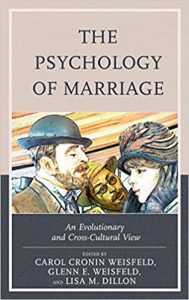 1. The Psychology of Marriage: An Evolutionary and Cross-Cultural View – Carol Cronin Weisfeld, Glenn E. Weisfeld, and Lisa Dillon
1. The Psychology of Marriage: An Evolutionary and Cross-Cultural View – Carol Cronin Weisfeld, Glenn E. Weisfeld, and Lisa Dillon
The Weisfeld's have conducted marriage research for 30+ years. They've examined relationships around the world to learn what makes them work or not. This compilation of articles includes topics such as:
- The functions, evolution, and development of marriage
- Whether culture, sex differences, similarities, and personality are important in marriage
- How families are changing in various countries including Russia, China, and Brazil
- The role humor plays in marriage
- Sex and cheating
- Pain points in marriage
- Cross-cultural marriage
The book is great for marriage and family therapists. It includes the Marriage and Relationship Questionnaire (MARQ). This tool is useful in any cultural setting for heterosexual and same-sex couples.
Available on Amazon.
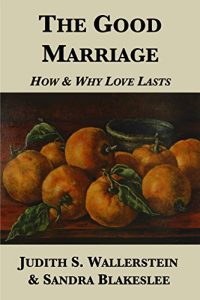 2. The Good Marriage: How and Why Love Lasts – Judith S. Wallerstein and Sandra Blakeslee
2. The Good Marriage: How and Why Love Lasts – Judith S. Wallerstein and Sandra Blakeslee
Through research, Wallerstein identified four types of marriage: romantic, rescue, companionate, and traditional.
The "Nine psychological tasks for a good marriage" article previously referenced came from her work.
For more information read this review from Utah Valley University.
Available on Amazon.
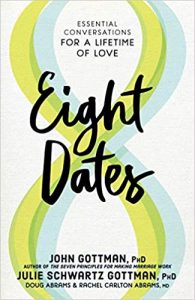 3. Eight Dates: Essential Conversations for a Lifetime of Love – John Gottman Ph.D. and Julie Schwartz Gottman Ph.D., Doug Abrams, and Carlton Abrams M.D.
3. Eight Dates: Essential Conversations for a Lifetime of Love – John Gottman Ph.D. and Julie Schwartz Gottman Ph.D., Doug Abrams, and Carlton Abrams M.D.
The couple's newest book is a fun and creative approach to connecting with your spouse. You experience eight dates focused on a key issue.
For example, trust, conflict, sex, money, family, adventure, spirituality, and dreams.
Interactive activities and prompts keep you and your partner engaged.
Available on Amazon.
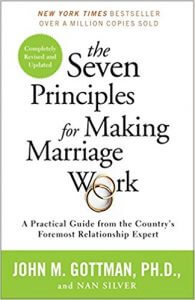 4. The Seven Principles for Making Marriage Work: A Practical Guide from the Country's Foremost Relationship Expert – John Gottman PhD and Nate Silver
4. The Seven Principles for Making Marriage Work: A Practical Guide from the Country's Foremost Relationship Expert – John Gottman PhD and Nate Silver
This book is a culmination of Gottman's research.
It explains the elements of a lasting marriage (covered in the Psychological Theories of Marriage section.)
Available on Amazon.
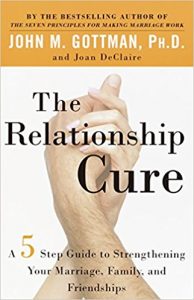 5. The Relationship Cure: A 5 Step Guide to Strengthening Your Marriage, Family, and Friendships – John Gottman
5. The Relationship Cure: A 5 Step Guide to Strengthening Your Marriage, Family, and Friendships – John Gottman
Gottman and DeClaire introduce the concept of the emotional "bid."
These are the small actions partners make to get attention.
The book includes questionnaires and exercises that will change the quality of your relationships.
Available on Amazon.
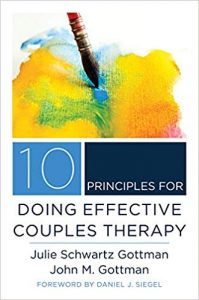 6. 10 Principles for Doing Effective Couples Therapy (North Series on Interpersonal Neurobiology) – Julie Schwartz Gottman, John M. Gottman Ph.D., and Daniel J. Siegel M.D.
6. 10 Principles for Doing Effective Couples Therapy (North Series on Interpersonal Neurobiology) – Julie Schwartz Gottman, John M. Gottman Ph.D., and Daniel J. Siegel M.D.
From an Amazon reviewer, "10 Principles for Doing Effective Couples Therapy" presents practical and specific suggestions that would be helpful for any therapist working in the often highly charged atmosphere of couples therapy.
Available on Amazon.
 7. The 5 Love Languages – Gary Chapman
7. The 5 Love Languages – Gary Chapman
This practical and insightful tool helps you reconnect with your partner.
You'll learn your partner's love language and how to speak it, while also discovering yours.
Available on Amazon.
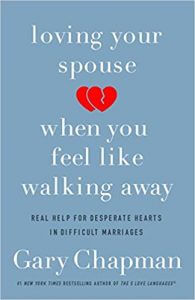 8. Loving Your Spouse When You Feel Like Walking Away: Real Help for Desperate Hearts in Difficult Marriages – Gary Chapman
8. Loving Your Spouse When You Feel Like Walking Away: Real Help for Desperate Hearts in Difficult Marriages – Gary Chapman
Marriage isn't easy. This book helps you better understand your partner.
You'll also learn to take responsibility for your thoughts, feelings, and behavior.
Each chapter covers serious challenges such as controlling or abusive partners, alcoholic or workaholic behaviors, and infidelity.
Available on Amazon.
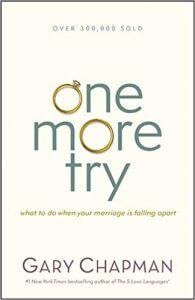 9. One More Try: What To Do When Your Marriage is Falling Apart – Gary Chapman
9. One More Try: What To Do When Your Marriage is Falling Apart – Gary Chapman
Chapman's perspective is biblical. Many of his lectures and books tackle marital strife from this point of view.
Christian or not, this book can help you rebuild your marriage.
Even when you and your partner separate there is hope. Chapman shows you how in this book.
Available on Amazon.
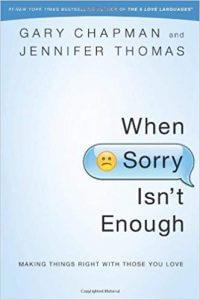 10. When Sorry Isn't Enough: Making Things Right with Those You Love – Gary D. Chapman
10. When Sorry Isn't Enough: Making Things Right with Those You Love – Gary D. Chapman
Ever wonder why your spouse isn't accepting your apology?
This book will teach you how to apologize so that the recipient feels your apology.
According to Chapman's research, there are several ways to apologize. Getting it right can make the difference between sleeping on the couch or cuddling in bed.
Available on Amazon.
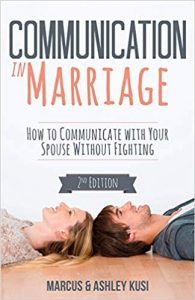 11. Communication in Marriage: How to Communicate with Your Spouse Without Fighting (Better Marriage Series) – Marcus Kusi and Ashley Kusi
11. Communication in Marriage: How to Communicate with Your Spouse Without Fighting (Better Marriage Series) – Marcus Kusi and Ashley Kusi
Although they're not professionals, the Kusi's have useful information to share about marriage. Their books are easy, quick reads, filled with actionable advice.
Written by a couple for newly-married couples, the text is engaging, and the tools well-researched. The Kusi's offer valuable insights and perspectives based on their journey.
You'll take away ideas for how to communicate through difficult emotions without anger. Their recommended reading list and reference section are worth a look.
Available on Amazon.
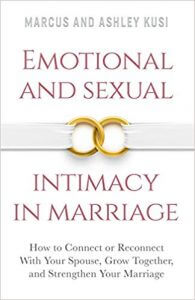 12. Emotional and Sexual Intimacy in Marriage: How to Connect or Reconnect With Your Spouse, Grow Together, and Strengthen Your Marriage (Better Marriage Series) – Marcus Kusi and Ashley Kusi
12. Emotional and Sexual Intimacy in Marriage: How to Connect or Reconnect With Your Spouse, Grow Together, and Strengthen Your Marriage (Better Marriage Series) – Marcus Kusi and Ashley Kusi
Approachable and down-to-earth, this book offers suggestions, tips, and questions partners can explore.
If you're lamenting the days when you talked for hours with each other, then this book might be useful to you.
Available on Amazon.
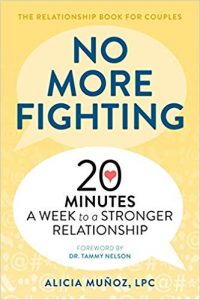
13. No More Fighting: The Relationship Book for Couples: 20 Minutes a Week to a Stronger Relationship – Alicia Munoz LPC
We all argue in some form with our partners. Whether it's the silent treatment, avoidance, or an all-out verbal barrage, we do it. Unfortunately, the aftermath can be difficult to clean up.
Munoz offers solid strategies for better navigating the inevitable challenges in any relationship.
Topics include everything from self-care to polyamory.
Available on Amazon.
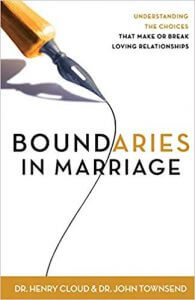 14. Boundaries in Marriage – Henry Cloud and John Townsend
14. Boundaries in Marriage – Henry Cloud and John Townsend
Based on Biblical precepts, Cloud and Townsend offer ten laws of boundaries. (Downloadable PDF) Applying them can help partners better understand pain points and egregious mistakes. The authors show you how to move past them and rebuild.
For those unfamiliar with the ten laws, they are:
- Sowing and reaping
- Responsibility
- Power
- Respect
- Motivation
- Evaluation
- Proactivity
- Envy
- Activity
- Exposure
Available on Amazon.
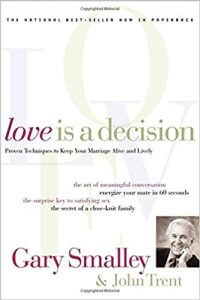 15. Love Is A Decision – Dr Gary Smalley and Dr John Trent
15. Love Is A Decision – Dr Gary Smalley and Dr John Trent
Smalley is a family counselor. Called a "must read manual for marriage" by an Amazon reviewer, this book is one guide to making a marriage work.
He's authored or co-authored sixteen books about relationships. In this book, he and Trent teach you how to honor your spouse, keep courtship alive, and rebuild trust. They also explore how to put your family first.
Available on Amazon.
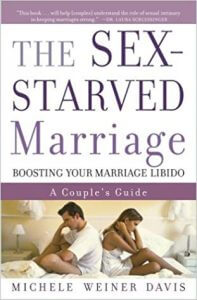 16. The Sex-Starved Marriage: Boosting Your Marriage Libido: A Couple's Guide – Michele Weiner Davis
16. The Sex-Starved Marriage: Boosting Your Marriage Libido: A Couple's Guide – Michele Weiner Davis
If you and your partner aren't connecting sexually, this book might be helpful.
Weiner Davis is a sex therapist who has worked with countless couples to rebuild their connection.
She's straightforward in her approach and analysis.
Available on Amazon.
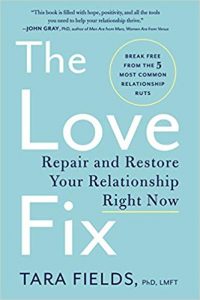 17. The Love Fix: Repair and Restore Your Relationship Right Now – Tara Fields PhD
17. The Love Fix: Repair and Restore Your Relationship Right Now – Tara Fields PhD
Fields is a licensed marriage and family therapist. She asserts that there are five common conflicts couples experience.
The trick is knowing which conflict surface during a fight. After you identify it, then you can explore fears you might harbor.
Her final step teaches partners to get in touch with their needs so that they can grow together. The focus is on developing gratitude, respect, and trust.
Available on Amazon.
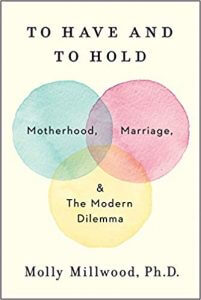 18. To Have and to Hold: Motherhood, Marriage, and the Modern Dilemma – Molly Millwood PhD
18. To Have and to Hold: Motherhood, Marriage, and the Modern Dilemma – Molly Millwood PhD
This book explores the well-being of new moms and the well-being of their relationship.
If you're worried about losing your identity after having children, this book is a good choice.
If you already fear you've become a shadow of your former self, Millwood's insights might help you.
Available on Amazon.
Bonus reading: The following books aren't specifically about marriage. They are about self-improvement and personal growth. Oftentimes, focusing on the self is a way to improve one's relationships with others.
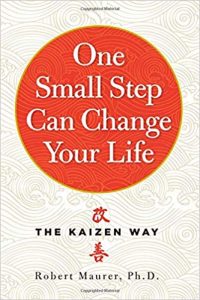 19. One Small Step Can Change Your Life: The Kaizen Way – Robert Maurer Ph.D.
19. One Small Step Can Change Your Life: The Kaizen Way – Robert Maurer Ph.D.
This might seem an odd addition to this list, but it's filled with gems. For example, Maurer asserts that from a spiritual perspective people have two fears. The fear of inadequacy and a fear of losing control. What could happen in a relationship if each partner understood this?
He gives this example to illustrate the point. Imagine your partner becomes angry because you're having a great time talking with someone else. If you understand that their fear is not being good enough, how might you respond differently? He goes on to say that no negotiation can happen unless and until you understand the fears of all involved.
Maurer offers another salient example of how adults dismiss their fears. When a child wakes in the middle of the night because of a nightmare, where does the child run? To the parent in almost every instance. We're wired to seek support from people around us. As adults, we begin to learn to suppress our fears. We even give fear labels like stress, anxiety, and anger. He points out that successful people identify their fears as fears.
In your relationship, what are your fears? Assuming you're not in an abusive relationship, they're likely to fall into the two categories above.
Available on Amazon.
 20. Ikigai: The Japanese Secret to a Long and Happy Life – Hector Garcia and Francesc Miralles
20. Ikigai: The Japanese Secret to a Long and Happy Life – Hector Garcia and Francesc Miralles
This concept boils down to purpose. What is your purpose as you travel through your day or your life?
A sense of purpose provides an internal compass. Waking up each day without one is like navigating an ocean during a storm.
Once you know your purpose, what are the odds that you'll begin attracting people to you who share it? How can knowing and communicating your purpose positively affect your relationships?
Not sure yet if you want to buy this book? Then read our introduction to Ikigai, as well as recommended Ikigai books and Ikigai quotes for more insight.
Available on Amazon.
Key Takeaways
It's not over, 'til it's over. When you're sick and tired of being "sick and tired," then you're in a position to make changes. This holds true for troubled relationships. If one or both of you still have skin in the game, then therapy could be a good fit.
There are many types of therapy. If one isn't working, find another approach with a different therapist.
Put as much if not more energy into the small positive aspects of your relationship that are working. Build on those.
Take the tips to heart and try them all before giving up. You owe it to yourself and your marriage.
Change can hurt. It's growing pains for the brain.
We're not trying to get back to the way we were. That's impossible. That would mean neither of you changed from the time you married to however many years later. How likely is that? Each moment or interaction we experience changes or influences us in some way.
People fear two things: being inadequate and losing control. Figure out what's at play when you're fighting with your spouse. Naming it creates space to explore it. Go deep like an EFT therapist.
A Take-Home Message
If you've never investigated VIA character strengths, you might find it helpful. You'll discover your top 5 "go to" strengths. There are 24 in all, and everyone uses each one to varying degrees. Humor is one of them. Since I'm learning to flex it more often, I'll end with this:
Q: Why is marriage like a nice suit?
A: At first it's a perfect fit, but after a while you need alterations.
Adaptability, flexibility, humor, and commitment does wonders for relationship-building.
Share your thoughts and experiences about marriage therapy in the comments. Let's learn from each other.
We hope you enjoyed reading this article. Don't forget to download our three Positive Relationships Exercises for free.
- American Association for Marriage and Family Therapy (n.d.). Marriage and Family Therapist: The family-friendly mental health professionals. Retrieved April 10, 2019, from https://www.aamft.org/Consumer_Updates/MFT.aspx
- Barnet, H. S. (1990). Divorce stress and adjustment model: Locus of control and demographic predictors. Journal of Divorce, 13(3), 93-110. Retrieved April 10, 2019, from https://eric.ed.gov/?id=ED290111
- Benson, K. (2016 October 21). 5 steps to fight better if your relationship is worth fighting for. The Gottman Institute. Retrieved April 11, 2019, from https://www.gottman.com/blog/5-steps-to-fight-better-if-your-relationship-is-worth-fighting-for/
- Benson, K. (2016 August 26). 3 steps to reconnect when you feel disconnected from your partner. The Gottman Institute. Retrieved April 11, 2019, from https://www.gottman.com/blog/3-steps-reconnect-feel-disconnected-partner/
- Cacioppo, J. T., Cacioppo, S. Gonzaga, G. C., Ogburn, E. L., & VanderWeele, T. J. (2013 June 3). Marital satisfaction and break-ups differ across on-line and off-line meeting venues. PNAS. Retrieved April 10, 2019, from
https://www.pnas.org/content/pnas/early/2013/05/31/1222447110.full.pdf. - DiDonato, T. (2014 January 10). 5 reasons why couples who sweat together stay together. Psychology Today. Retrieved April 11, 2019, from https://www.psychologytoday.com/us/blog/meet-catch-and-keep/201401/5-reasons-why-couples-who-sweat-together-stay-together
- eHarmony (n.d.). The eHarmony 29 dimensions of compatibility explained. Retrieved April 10, 2019, from https://www.eharmony.co.uk/dating-advice/using-eharmony/eharmony-29-dimensions-compatibility-explained#.XK53_evYrq0
- Estroff Marano, H. & Flora, C. (2004, June 9). The truth about compatibility. Expert opinions on love and compatibility, and the interaction between biology and behavior. Psychology Today. Retrieved April 10, 2019, from https://www.psychologytoday.com/us/articles/200409/the-truth-about-compatibility
- Gaspard, T. (2015 July 23). Timing is everything when it comes to marriage counseling. The Gottman Institute. Retrieved April 10, 2019, from https://www.gottman.com/blog/timing-is-everything-when-it-comes-to-marriage-counseling/
- Gaspard, T. (2016 October 17). Learning to love again after an affair. The Gottman Institute. Retrieved April 11, 2019, from https://www.gottman.com/blog/learning-to-love-again-after-an-affair/
- Gottman Method (n.d.). The Gottman Institute. Retrieved March 18, 2019, from https://www.gottman.com/about/the-gottman-method/
- Holt-Lunstad, J., Birmingham, W., & Jones, B. Q. (2008). Is there something unique about marriage? The relative impact of marital status, relationship quality, and network social support on ambulatory blood pressure and mental health. Annals of Behavioral Medicine. 35(2), p. 239-244.
- Instant Chemistry (n.d.) Retrieved April 10, 2019, from http://instantchemistry.com/relationship-compatibility/
- Johnson, S. (2014 February 19). What is Emotionally Focused Therapy (EFT)? Retrieved April 11, 2019, from https://youtu.be/xQCg-jC25fo
- Karney, B. R. (2010 February). Keeping marriages healthy, and why it's so difficult. Science Briefs. American Psychological Association. Retrieved April 8, 2019, from https://www.apa.org/science/about/psa/2010/02/sci-brief
- Kubler-Ross, E. (1969). On death and dying. New York, NY: Scribner
- Leeuw, J. (2015, April 4). Making marriages work: Common factors of marriage theories. Scholar Works at WMU. Western Michigan University. Retrieved April 2, 2019, from https://scholarworks.wmich.edu/cgi/viewcontent.cgi?article=3591&context=honors_theses
- Mayo Clinic (n.d.). Stress relief from laughter? It's no joke. Healthy Lifestyle: Stress Management. Retrieved April 11, 2019, from https://www.mayoclinic.org/healthy-lifestyle/stress-management/in-depth/stress-relief/art-20044456
- McGonigal, K. (2015). The upside of stress: Why stress is good for you and how to get good at it. New York, NY: Avery
- Nakonezny, P.A. & Denton W. H. (2008). Marital relationships: A social exchange theory perspective. The American Journal of Family Therapy, 36, p. 402-412. Retrieved April 2, 2019, from https://faculty.mccneb.edu/ajmaley/images/Marriage-A%20Social%20Exchange%20Perspective.pdf
- Robles, T. F., Slatcher, R. B., Trombello, J. M., & McGinn, M. M. (2014). Marital quality and health: A meta-analysis review. Psychological Bulletin, 140(1), p. 140-187.
- Sternberg, R. J. (n.d.). Duplex Theory of Love: Triangular Theory of Love and Theory of Love as a Story. Retrieved April 3, 2019, from http://www.robertjsternberg.com/love
- Stronger Families (2015 November 23). Falling in love for all the right reasons. Retrieved April 10, 2019, from https://youtu.be/rGfaMvhYbZY
- Tasker, R. (n.d.). 20 helpful marriage counseling questions to ask your spouse. Marriage counseling questions: A guide to effective relationship counseling. GuideDoc. Retrieved April 7, 2019, from https://guidedoc.com/marriage-counseling-questions
- Waring, Edward M. Enhancing Marital Intimacy Through Facilitating Cognitive Self-Disclosure. New York: Brunner/Mazel, Inc., 1988. xiii-212. Print.
- Weiner-Davis, M. (2014, April 29). The sex-starved marriage. TEDxCU. Retrieved April 3, 2019, from https://youtu.be/Ep2MAx95m20
- Wood, J. (2018 October 5). The United States divorce rate is dropping, thanks to millennials. World Economic Forum. Retrieved April 11, 2019, from https://www.weforum.org/agenda/2018/10/divorce-united-states-dropping-because-millennials/
Source: https://positivepsychology.com/marriage-fulfillment-lifelong-relationship/
Posted by: zulmashimurae0209551.blogspot.com
Post a Comment for "divorce reconciliation michigan pdf free download"